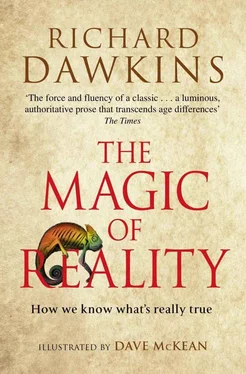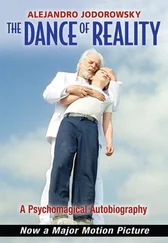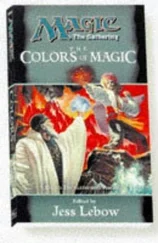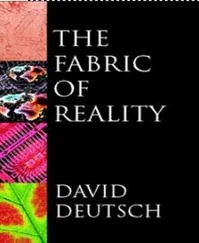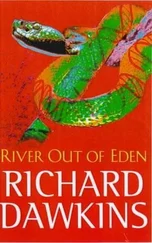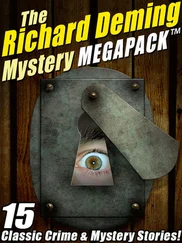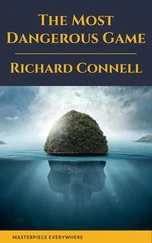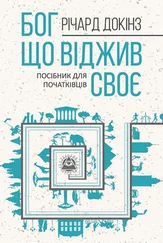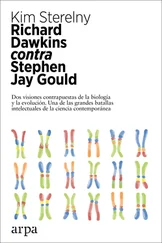Let’s resume our journey into the past, and look at some of the stations on the way back to that fish. Suppose we have just arrived in our time machine at the station labelled ‘Six Million Years Ago’. What shall we find there? So long as we make a point of being in Africa, we’ll find our 250,000-greats-grandparents (give or take some generations). They’ll be apes, and they might look a bit like chimpanzees. But they won’t be chimpanzees. Instead, they’ll be the ancestors that we share with chimpanzees. They’ll be too different from us to mate with us, and too different from chimpanzees to mate with chimpanzees. But they will be able to mate with the passengers we took on board at Station Five Million Nine Hundred and Ninety Thousand Years Ago. And probably those from Station Five Million Nine Hundred Thousand Years Ago, too. But probably not those who joined us at Station Four Million Years Ago.
Let’s now resume our ten-thousand-year hops, all the way back to Station Twenty-Five Million Years Ago. There we shall find your (and my) one-and-a-half-million-greats-grandparents – at an approximate estimate. They will not be apes, for they will have tails. We would call them monkeys if we met them today, although they are no more closely related to modern monkeys than they are to us. Although very different from us, and incapable of breeding with us or with modern monkeys, they will breed happily with the all-but-identical passengers who joined us at Station Twenty-Four Million Nine Hundred and Ninety Thousand Years Ago. Gradual, gradual change, all the way.
On we go, back and back, ten thousand years at a time, finding no noticeable change at each stop. Let’s pause to see who greets us when we reach Station Sixty-Three Million Years Ago. Here we can shake hands (or should that be paws?) with our seven-million-greats-grandparents. They look something like lemurs or bushbabies, and they are indeed the ancestors of all modern lemurs and bushbabies, as well as the ancestors of all modern monkeys and apes, including us.
They are as closely related to modern humans as they are to modern monkeys, and no more closely to modern lemurs or bushbabies. They wouldn’t be able to mate with any modern animals. But they would be able to mate with the passengers we picked up at Station Sixty-Two Million Nine Hundred and Ninety Thousand Years Ago. Let’s welcome them aboard the time machine, and speed on backwards.
At Station One Hundred and Five Million Years Ago we’ll meet our 45-million-greats-grandfather. He is also the grand ancestor of all the modern mammals except marsupials (now found mostly in Australia, plus a few in America) and monotremes (duckbilled platypuses and spiny anteaters, now found only in Australia/New Guinea). He is equally closely related to all modern mammals, although he may look a bit more like some of them than others.
Station Three Hundred and Ten Million Years Ago presents us with our 170-million-greats-grandmother. She is the grand ancestor of all modern mammals, all modern reptiles – snakes, lizards, turtles, crocodiles – and all dinosaurs (including birds, because birds arose from certain kinds of dinosaur). She is equally distantly related to all those modern animals, although she looks more like a lizard. What that means is that lizards have changed less since her time than, say, mammals have.
Seasoned time-travellers as we are by now, it isn’t far to go until we hit the fish that I mentioned earlier. Let’s make one more stop on the way: at Station Three Hundred and Forty Million Years Ago, where we meet our 175-million-greats-grandfather. He looks a bit like a newt, and is the grand ancestor of all modern amphibians (newts and frogs) as well as of all the other land vertebrates.
And so to Station Four Hundred and Seventeen Million Years Ago and your 185-million-greats-grandfather, the fish we met before. From there we could go on even further back in time, meeting more and more distant great-grandparents, including various kinds of fish with jaws, then fish without jaws, then… well, then our knowledge starts to fade into a kind of mist of uncertainty, for these very ancient times are where we start to run out of fossils.
DNA tells us we are all cousins
Although we may lack the fossils to tell us exactly what our very ancient ancestors looked like, we are in no doubt at all that all living creatures are our cousins, and cousins of each other. And we also know which modern animals are close cousins of each other (like humans and chimpanzees, or rats and mice), and which are distant cousins of each other (like humans and cuckoos, or mice and alligators). How do we know? By systematically comparing them. Nowadays, the most powerful evidence comes from comparing their DNA.
DNA is the genetic information that all living creatures carry in each of their cells. The DNA is spelled out along massively coiled ‘tapes’ of data, called ‘chromosomes’. These chromosomes really are very like the kind of data tapes you’d feed into an old-fashioned computer, because the information they carry is digital and is strung along them in order. They consist of long strings of code ‘letters’, which you can read and count: each letter is either there or it isn’t – there are no half measures. That’s what makes it digital, and why we say DNA is ‘spelled out’.
All genes, in every animal, plant and bacterium that has ever been looked at, are coded messages for how to build the creature, written in a standard alphabet. The alphabet has only four letters to choose from (as opposed to the 26 letters of the English alphabet). We write the DNA letters as A, T, C and G. The same genes occur in many different creatures, with a few revealing differences. For example, there’s a gene called FoxP2, which is shared by all mammals and lots more creatures besides. The gene is a string of more than 2,000 letters.
You can tell that FoxP2 is the same gene in all mammals because the great majority of the code letters are the same. Not quite all the chimpanzee letters are the same as ours, and somewhat fewer of the mouse ones are. Of the total of 2,076 letters in FoxP2, the chimpanzee has nine letters different from ours, while the mouse has 139 letters different. And that pattern holds for other genes too. That explains why chimpanzees are very like us, while mice are less so.
Chimpanzees are our close cousins, mice are our more distant cousins. ‘Distant cousins’ means that the most recent ancestor we share with them lived a long time ago. Monkeys are closer to us than mice but further from us than chimpanzees. Baboons and rhesus macaques are both monkeys, close cousins of each other, and with almost identical FoxP2 genes. They are exactly as distant from chimps as they are from us; and the number of DNA letters in FoxP2 that separate baboons from chimps is almost exactly the same (24) as the number of letters that separate baboons from us (23). It all fits.
And, just to finish off this little thought, frogs are much more distant cousins of all mammals. All mammals have approximately the same number of letter differences from a frog (about 140), for the simple reason that they are all exactly equally close cousins: all mammals share a more recent ancestor with each other (about 180 million years ago) than they do with the frog (about 340 million years ago).
But of course not all humans are the same as all other humans, and not all baboons are the same as all other baboons and not all mice are the same as all other mice. We could compare your genes with mine, letter by letter. And the result? We’d turn out to have even more letters in common than either of us does with a chimpanzee. But we’d still find some letters that are different. Not many, and there’s no particular reason to single out the FoxP2 gene. But if you counted up the number of letters all humans share in all our genes, it would be more than any of us shares with a chimpanzee. And you share more letters with your cousin than you share with me. And you share even more letters with your mother and your father, and (if you have one) with your sister or brother. In fact, you can work out how closely related any two people are to each other by counting the number of DNA letters they share. It’s an interesting count to make, and it is something we are probably going to hear more about in the future. For example, the police will be able to track somebody down if they have the DNA ‘fingerprint’ of his brother.
Читать дальше
